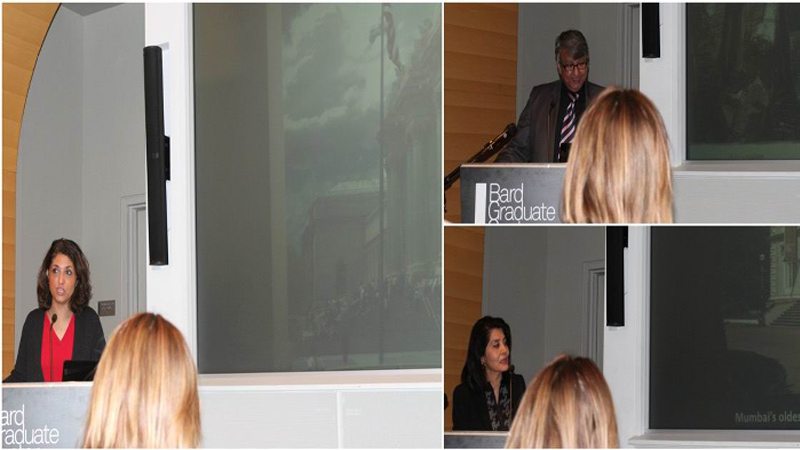Today, the lived reality of 100 years of British Raj in India is only anticipated through history books and oral accounts. The stories of fortunes and misfortunes of colonisation mostly stay in the realm of imagination that people construct with echoes of the past, having no first-hand experience.
 A recent festival in New York, “Lahore on my Mind” curated by Sugata Ray, attempted to commemorate the cultural legacies of colonial times. The festival took the exhibition John Lockwood Kipling: Arts & Crafts in the Punjab and London as a starting point to reflect on the role of visual arts, performative practices and literary cultures in shaping South Asia’s aesthetics, arts, and cultural politics in a globalised world.
A recent festival in New York, “Lahore on my Mind” curated by Sugata Ray, attempted to commemorate the cultural legacies of colonial times. The festival took the exhibition John Lockwood Kipling: Arts & Crafts in the Punjab and London as a starting point to reflect on the role of visual arts, performative practices and literary cultures in shaping South Asia’s aesthetics, arts, and cultural politics in a globalised world.
Bringing together scholars from Mumbai, Lahore, London, New York, Vermont, and Hawaii, the exhibition was a result of a three-year international research project. It focused on Lockwood Kipling’s curatorship of the Lahore Museum, his journalism over 25 years in India, and his influence on his son, the writer and poet, Rudyard Kipling (1865-1936)
The festival carefully encapsulated poetry, visual art and academic interventions through different panels reflecting on the past and the present to explore the early modern, colonial, and contemporary cultural worlds of South Asia. Pakistani-American contemporary artist, Shazia Sikander opened the festival. In her talk she said that hope for the future of Arts in Pakistan lies in collaboration and co-operation of different educational and professional institutions.
An exclusive panel “Outside Kipling’s Wonder House”, or the Ajaib-Gher as the ‘natives’ called it discussed the present of South Asian visual arts inside and outside the region. Navina Najat Haidar, Curator of Islamic Art at the Metropolitan Museum of Art in New York City opened the discussion with a brief introduction of galleries exhibiting Muslim art in the Metropolitan Museum. Her discussion emphasized on the fact that in order to trace the legacy of South Asian Art it is important to pay due attention to its international connections beyond the South Asian borders. Her slide show included the collections from Umayyad, Safavid, Abbasid and Ottoman dynasties moving on to Sultans, Rajputs and the Mughals of India. Moreover, she mentioned that currently the museum is working to add a section on Lahore in Jahangir’s era. Talking about Lahore she commented that Kippling who emerged as the most important figure in Punjab, for his work to preserve and promote art and craft, is often misquoted and misread.
Akbar and Kipling are just metaphors of the past for the western audience. However, for us, it is home which is changing and the heritage which we have lost to rapid urbanisation, says Nadeem Omar Tarar
Second speaker on the panel, Nadeem Omar Tarar, Director of National College of Arts Pakistan (NCA), critically analyzed the exaggerated role of Lockwood Kipling which has not only overshadowed the contributions of many other legends like Ram Singh but has also concealed the tyrannies of colonial administration of which Lockwood Kipling was a part. In order to support his argument Dr. Nadeem quoted Kipling’s own biography and letters of Bhai Ram Singh, expressing grief for the differential and racializing behavior of Kipling. In addition to that, pointing to the problem of history writing, Dr. Nadeem argued, “Lockwood Kipling’s ‘myth’ is born out of Rudyard Kipling who wrote about India for British audience and his discourse later got internalized by Indians as well”. He delved deep into the creation and transformation of Mayo school of arts in Lahore now known as National college of Arts. Dr. Nadeem walked the audience through the discovery and establishment of NCA archives during his tenure at NCA Lahore campus. In an answer to a question about the future of arts and crafts in Pakistan he said, “Unfortunately, on one hand we do not have cultural nationalism and on the other hand, in our country, Artisans live in a craft world and modern artists live in a global world. This dichotomy has disconnected us from art and folk as a society.” About the exhibition, he said, it is an epiphenomenon for western audience nothing more than an imperial adjunct. Akbar and Kipling are the metaphors of the past for them. However, for us, it is home which is changing and the heritage which we have lost for the sake of rapid urbanization.



Therefore, this attempt to honour the cultural heritage of Lahore was quite incomplete.
Published in Daily Times, November 18th 2017.